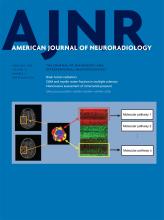Index by author
Hakansson, I.
- Adult BrainYou have accessImproved Precision of Automatic Brain Volume Measurements in Patients with Clinically Isolated Syndrome and Multiple Sclerosis Using Edema CorrectionJ.B.M. Warntjes, A. Tisell, I. Håkansson, P. Lundberg and J. ErnerudhAmerican Journal of Neuroradiology February 2018, 39 (2) 296-302; DOI: https://doi.org/10.3174/ajnr.A5476
Hall, L.
- Adult BrainOpen AccessRadiomics in Brain Tumor: Image Assessment, Quantitative Feature Descriptors, and Machine-Learning ApproachesM. Zhou, J. Scott, B. Chaudhury, L. Hall, D. Goldgof, K.W. Yeom, M. Iv, Y. Ou, J. Kalpathy-Cramer, S. Napel, R. Gillies, O. Gevaert and R. GatenbyAmerican Journal of Neuroradiology February 2018, 39 (2) 208-216; DOI: https://doi.org/10.3174/ajnr.A5391
Han, M.-K.
- FELLOWS' JOURNAL CLUBNeurointerventionYou have accessFeasibility of Permanent Stenting with Solitaire FR as a Rescue Treatment for the Reperfusion of Acute Intracranial Artery OcclusionH.G. Woo, L. Sunwoo, C. Jung, B.J. Kim, M.-K. Han, H.-J. Bae, Y.J. Bae, B.S. Choi and J.H. KimAmerican Journal of Neuroradiology February 2018, 39 (2) 331-336; DOI: https://doi.org/10.3174/ajnr.A5477
From January 2011 through January 2016, among 2979 patients with acute ischemic stroke, the authors identified 27 patients who underwent permanent stent placement (13 patients with the Solitaire FR and 14 patients with other self-expanding stents). The postprocedural modified TICI grade and angiographic and clinical outcomes were assessed. Stent placement was successful in all cases. Modified TICI 2b=3 reperfusion was noted in 84.6% of the Solitaire group and in 78.6% of the other stent group. They conclude that permanent stent placement with the Solitaire FR compared with other self-expanding stents appears to be feasible and safe as a rescue tool for refractory intra-arterial therapy.
Hans, F.-J.
- FELLOWS' JOURNAL CLUBSpine Imaging and Spine Image-Guided InterventionsYou have accessClinical and Radiologic Characteristics of Deep Lumbosacral Dural Arteriovenous FistulasF. Jablawi, O. Nikoubashman, G.A. Schubert, M. Dafotakis, F.-J. Hans and M. MullAmerican Journal of Neuroradiology February 2018, 39 (2) 392-398; DOI: https://doi.org/10.3174/ajnr.A5497
Twenty patients with deep lumbosacral spinal dural arteriovenous fistulas were included in this series. Cord T2 hyperintensity and contrast enhancement were present in most cases. The filum vein and/or lumbar veins were dilated in 95% of patients. Time-resolved contrast-enhanced dynamic MRA indicated a spinal DAVF at or below the L5 vertebral level in 7/8 (88%) patients who received time-resolved contrast-enhanced dynamic MRA before DSA. A bilateral arterial supply of the fistula was detected via DSA in 5 (25%) patients. The authors conclude that time-resolved contrast-enhanced dynamic MRA facilitates the detection of the drainage vein and helps to localize deep lumbosacral-located fistulas with a high sensitivity before DSA. Definite detection remains challenging and requires conventional spinal angiography.
Harder, D.
- Spine Imaging and Spine Image-Guided InterventionsYou have accessSystematic Radiation Dose Reduction in Cervical Spine CT of Human Cadaveric Specimens: How Low Can We Go?M. Tozakidou, C. Reisinger, D. Harder, J. Lieb, Z. Szucs-Farkas, M. Müller-Gerbl, U. Studler, S. Schindera and A. HirschmannAmerican Journal of Neuroradiology February 2018, 39 (2) 385-391; DOI: https://doi.org/10.3174/ajnr.A5490
Harnsberger, H.R.
- Head and Neck ImagingYou have accessIntranasal Esthesioneuroblastoma: CT Patterns Aid in Preventing Routine Nasal PolypectomyM.E. Peckham, R.H. Wiggins, R.R. Orlandi, Y. Anzai, W. Finke and H.R. HarnsbergerAmerican Journal of Neuroradiology February 2018, 39 (2) 344-349; DOI: https://doi.org/10.3174/ajnr.A5464
Haswell, C.C.
- EDITOR'S CHOICEAdult BrainOpen AccessWhite Matter Changes Related to Subconcussive Impact Frequency during a Single Season of High School FootballS.J. Kuzminski, M.D. Clark, M.A. Fraser, C.C. Haswell, R.A. Morey, C. Liu, K.R. Choudhury, K.M. Guskiewicz and J.R. PetrellaAmerican Journal of Neuroradiology February 2018, 39 (2) 245-251; DOI: https://doi.org/10.3174/ajnr.A5489
Seventeen male athletes (mean age, 16 years) underwent MR imaging before and after the football season. Changes in fractional anisotropy across the white matter skeleton were assessed with Tract-Based Spatial Statistics and ROI analysis. The mean number of impacts over a 10-g threshold sustained was 414. Voxelwise analysis failed to show significant changes in fractional anisotropy across the season or a correlation with impact frequency, after correcting for multiple comparisons. ROI analysis showed significant decreases in fractional anisotropy in the fornix-stria terminalis and cingulum hippocampus, which were related to impact frequency. The authors conclude that subclinical neurotrauma related to participation in American football may result in white matter injury and that alterations in white matter tracts within the limbic system may be detectable after only 1 season of play at the high school level.
Hatsukami, T.S.
- Extracranial VascularYou have accessCarotid Artery Wall Imaging: Perspective and Guidelines from the ASNR Vessel Wall Imaging Study Group and Expert Consensus Recommendations of the American Society of NeuroradiologyL. Saba, C. Yuan, T.S. Hatsukami, N. Balu, Y. Qiao, J.K. DeMarco, T. Saam, A.R. Moody, D. Li, C.C. Matouk, M.H. Johnson, H.R. Jäger, M. Mossa-Basha, M.E. Kooi, Z. Fan, D. Saloner, M. Wintermark, D.J. Mikulis and B.A. Wasserman on behalf of the Vessel Wall Imaging Study Group of the American Society of NeuroradiologyAmerican Journal of Neuroradiology February 2018, 39 (2) E9-E31; DOI: https://doi.org/10.3174/ajnr.A5488
Henninger, N.
- Adult BrainOpen AccessLeukoaraiosis Attenuates Diagnostic Accuracy of Large-Vessel Occlusion ScalesY. Mayasi, R.P. Goddeau, M. Moonis, B. Silver, A.H. Jun-O'Connell, A.S. Puri and N. HenningerAmerican Journal of Neuroradiology February 2018, 39 (2) 317-322; DOI: https://doi.org/10.3174/ajnr.A5473
Hijaz, T.A.
- LetterYou have accessReply:A.W. Korutz, E.J. Russell, T.A. Hijaz, J.D. Collins, B.P. Knight and A.J. NemethAmerican Journal of Neuroradiology February 2018, 39 (2) E37; DOI: https://doi.org/10.3174/ajnr.A5467








